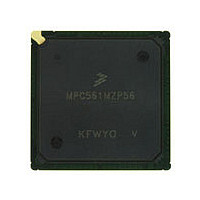MPC561MZP56 Freescale, MPC561MZP56 Datasheet - Page 458

MPC561MZP56
Manufacturer Part Number
MPC561MZP56
Description
Manufacturer
Freescale
Datasheet
1.MPC561MZP56.pdf
(1420 pages)
Specifications of MPC561MZP56
Cpu Family
MPC56x
Device Core
PowerPC
Device Core Size
32b
Frequency (max)
56MHz
Interface Type
QSPI/SCI/SPI/UART
Total Internal Ram Size
32KB
# I/os (max)
56
Number Of Timers - General Purpose
22
Operating Supply Voltage (typ)
2.6/5V
Operating Supply Voltage (max)
2.7/5.25V
Operating Supply Voltage (min)
2.5/4.75V
On-chip Adc
2(32-chx10-bit)
Instruction Set Architecture
RISC
Operating Temp Range
-40C to 125C
Operating Temperature Classification
Automotive
Mounting
Surface Mount
Pin Count
388
Package Type
BGA
Program Memory Type
ROMLess
Program Memory Size
Not Required
Lead Free Status / RoHS Status
Not Compliant
Available stocks
Company
Part Number
Manufacturer
Quantity
Price
Company:
Part Number:
MPC561MZP56
Manufacturer:
Freescale Semiconductor
Quantity:
10 000
Company:
Part Number:
MPC561MZP56R2
Manufacturer:
Freescale Semiconductor
Quantity:
10 000
- Current page: 458 of 1420
- Download datasheet (11Mb)
U-Bus to IMB3 Bus Interface (UIMB)
It is possible for multiple interrupt sources to assert the same interrupt level. To reduce the latency, it is a
good practice for each interrupt source to assert an interrupt on a level on which no other interrupt source
is mapped.
12.4.2
The IMB3 has 10 lines for interrupt support. Eight lines are for interrupts and two are for interrupt level
byte select (ILBS). These lines will transfer the 32 interrupt levels to the interrupt synchronizer. A diagram
of the interrupt flow is shown in
Latching 32 interrupt levels using eight IMB3 interrupt lines is accomplished with a 4:1 time-multiplexing
scheme. The UIMB drives two signals (ILBS[0:1]) with a multiplexer select code that tells all interrupting
modules on the IMB3 about which group of signals to drive during the next clock. See
12.4.3
The IMB3 interface drives the ILBS signals continuously, incrementing through a code sequence (0b00,
0b01, 0b10, 0b11) once every clock. The UMCR[IRQMUX] bits in the IMB3 module configuration
register select which type of multiplexing the interrupt synchronizer will perform. The IRQMUX field can
select time-multiplexing protocols for 8, 16, 24 or 32 interrupt sources. These protocols would take one,
two, three or four clocks, respectively.
Table 12-4
this case the ILBS lines remain at 0b00 at all times. In this mode, no interrupts from IMB3 modules which
assert on levels 8 through 31 are ever latched by the interrupt synchronizer. SRESET will not clear the
IRQMUX bits, so time multiplexing will be enabled with the previous setup after SRESET is released.
The timing for the scheme and the values of ILBS and the interrupt levels driven onto the IMB3 IRQ lines
are shown in
of two clocks before the interrupt request can reach the interrupt synchronizer.
12-4
Byte-enable
to IMB3
shows ILBS sequencing. Programming IRQMUX[0:1] to 0b00 disables time multiplexing. In
IMB3 Interrupt Multiplexing
ILBS Sequencing
Figure
2
12-5. This scheme causes a maximum latency of four clocks and an average latency
Byte Count
Block
Figure 12-4. Interrupt Synchronizer Signal Flow
Figure
MPC561/MPC563 Reference Manual, Rev. 1.2
IMB3 Interrupt
Byte-enables
12-4.
4
8
[16:23]
UIPEND
Register
[24:31]
[8:15]
[0:7]
8
U-bus Interrupt
Level[0:7]
U-bus
Data[0:31]
Freescale Semiconductor
Figure
12-5.
Related parts for MPC561MZP56
Image
Part Number
Description
Manufacturer
Datasheet
Request
R

Part Number:
Description:
MPC5 1K0 5%
Manufacturer:
TE Connectivity
Datasheet:

Part Number:
Description:
MPC5 500R 5%
Manufacturer:
TE Connectivity
Datasheet:

Part Number:
Description:
MPC5 5K0 5%
Manufacturer:
Tyco Electronics
Datasheet:

Part Number:
Description:
MPC5 5R0 5%
Manufacturer:
Tyco Electronics
Datasheet:

Part Number:
Description:
MPC5 50K 5%
Manufacturer:
Tyco Electronics
Datasheet:

Part Number:
Description:
MPC5 1R0 5%
Manufacturer:
Tyco Electronics
Datasheet:

Part Number:
Description:
TOWER ELEVATOR BOARDS HARDWARE
Manufacturer:
Freescale Semiconductor
Datasheet:

Part Number:
Description:
TOWER SERIAL I/O HARDWARE
Manufacturer:
Freescale Semiconductor
Datasheet:

Part Number:
Description:
LCD MODULE FOR TWR SYSTEM
Manufacturer:
Freescale Semiconductor
Datasheet:

Part Number:
Description:
DAUGHTER LCD WVGA I.MX51
Manufacturer:
Freescale Semiconductor
Datasheet:

Part Number:
Description:
TOWER SYSTEM BOARD MPC5125
Manufacturer:
Freescale Semiconductor
Datasheet:












